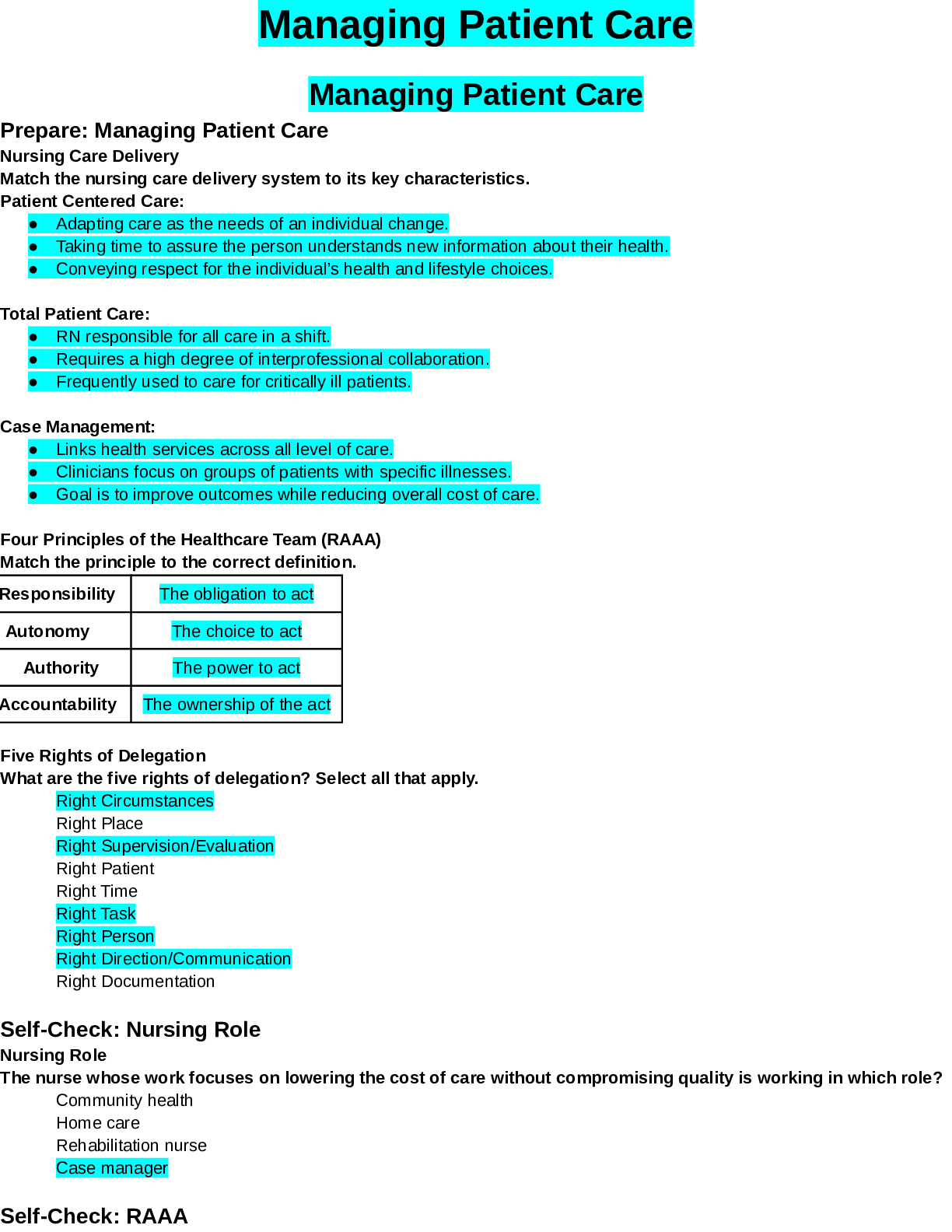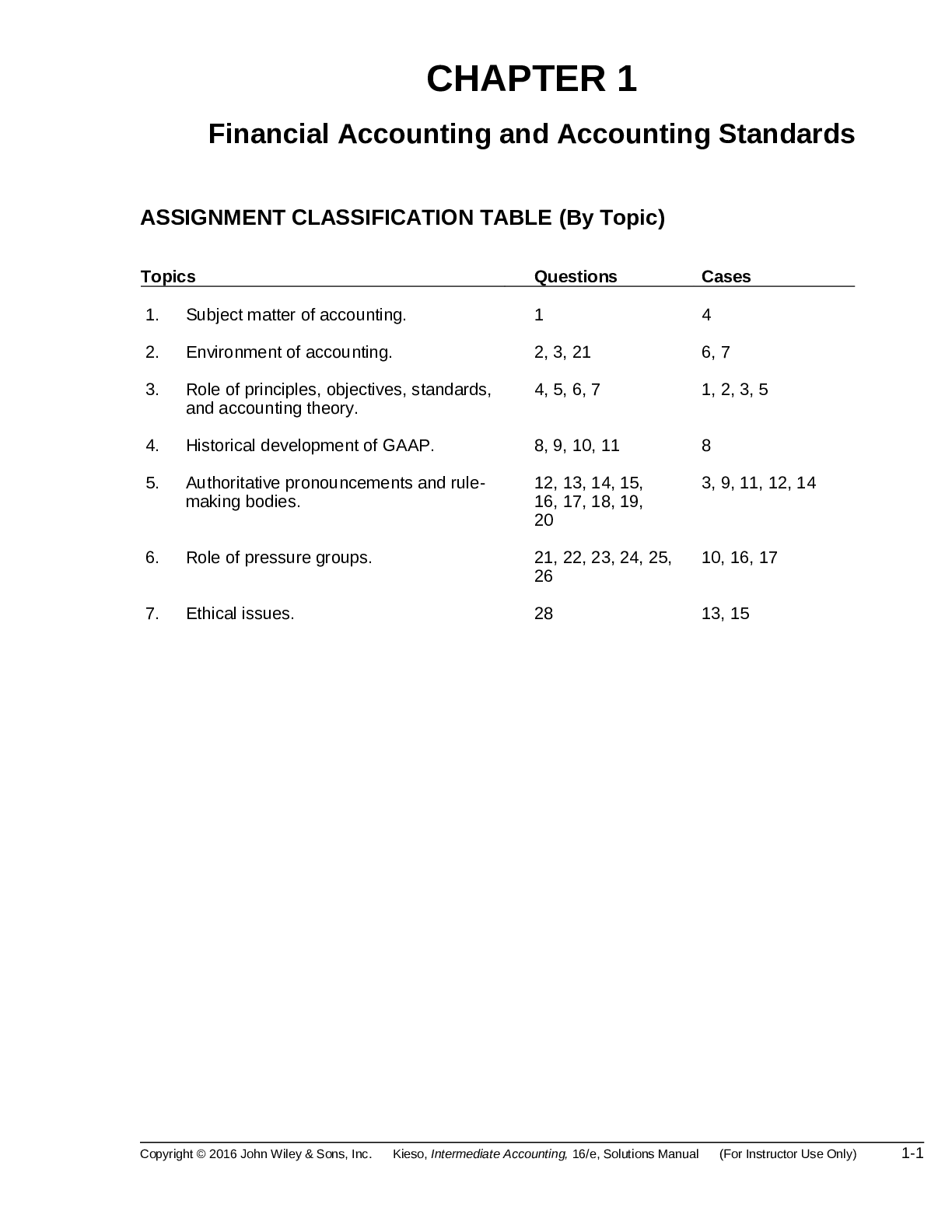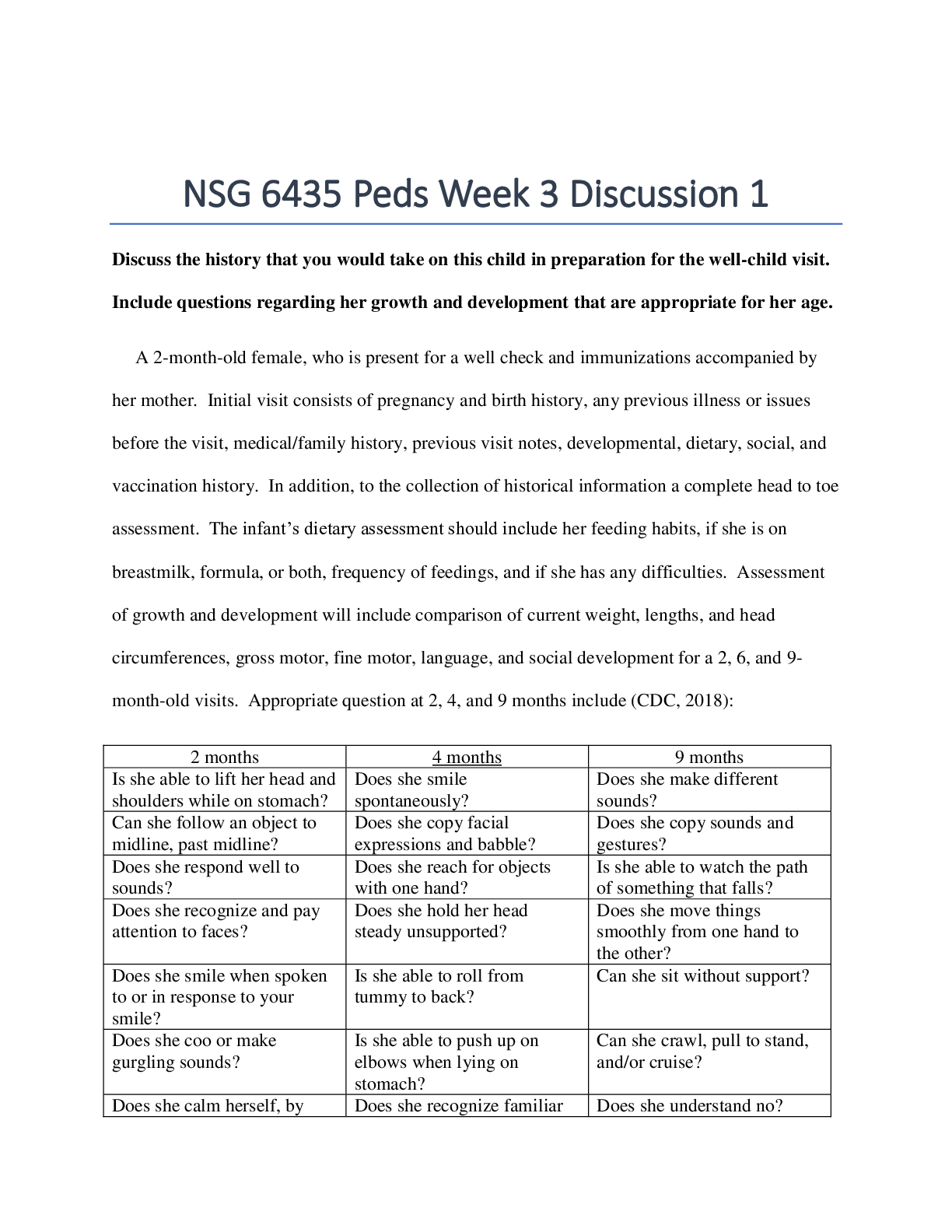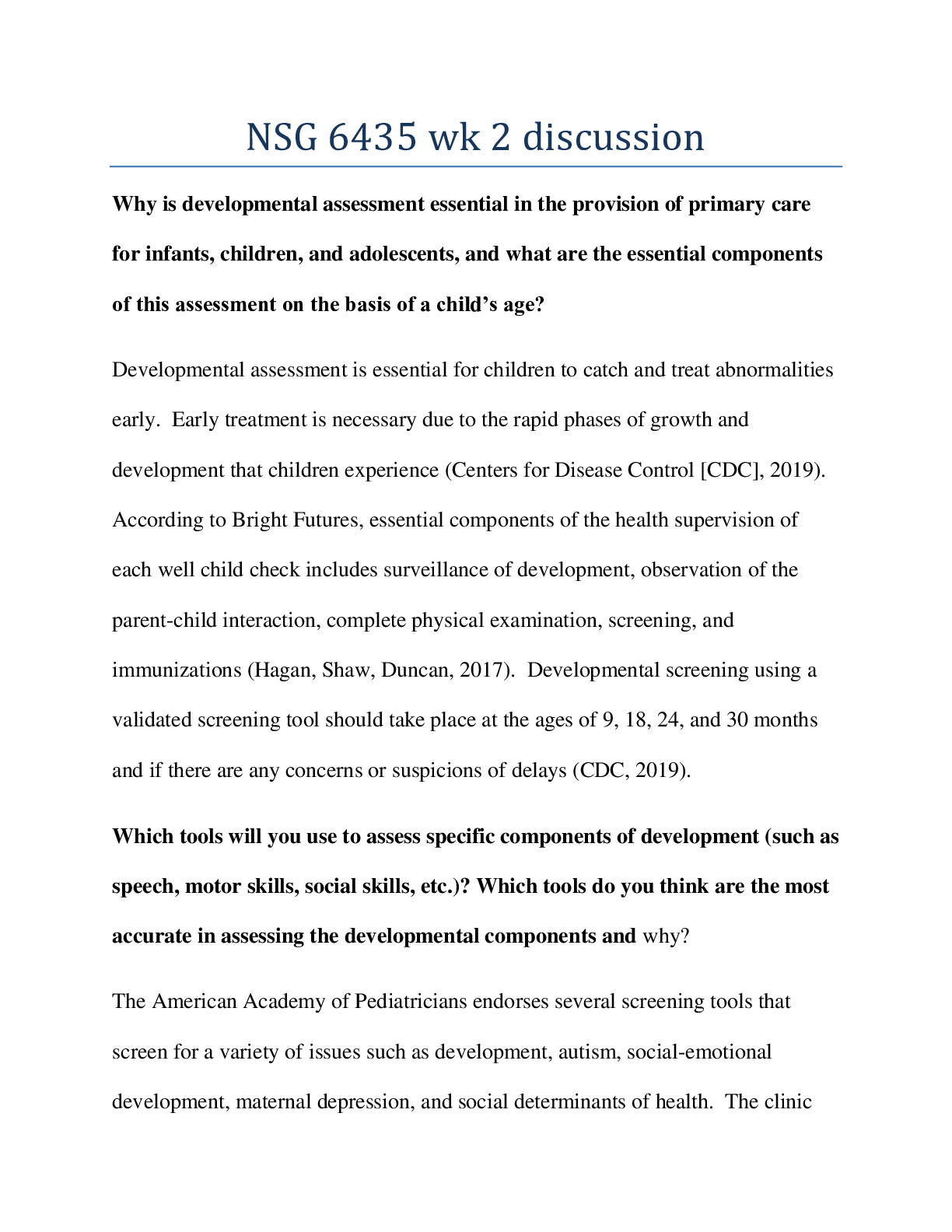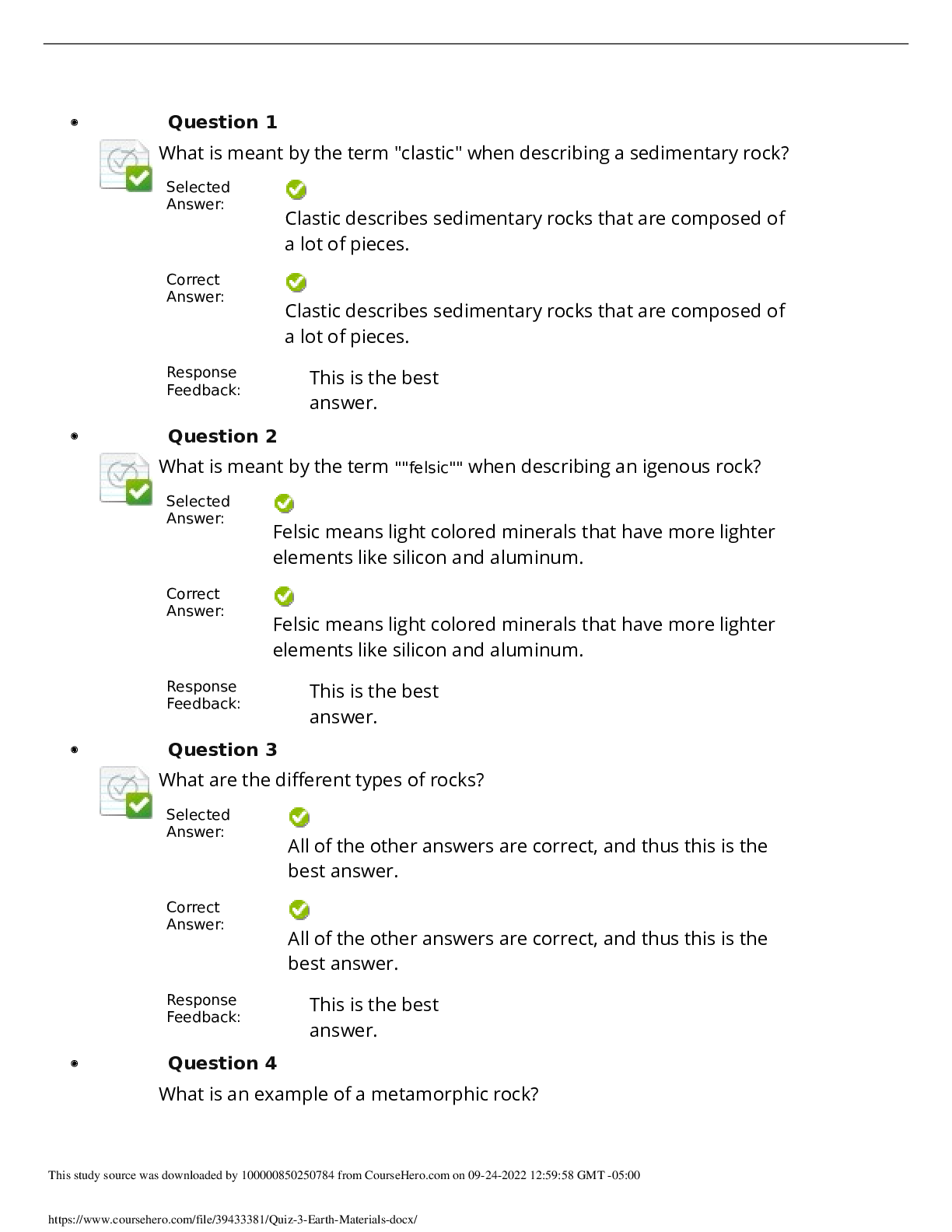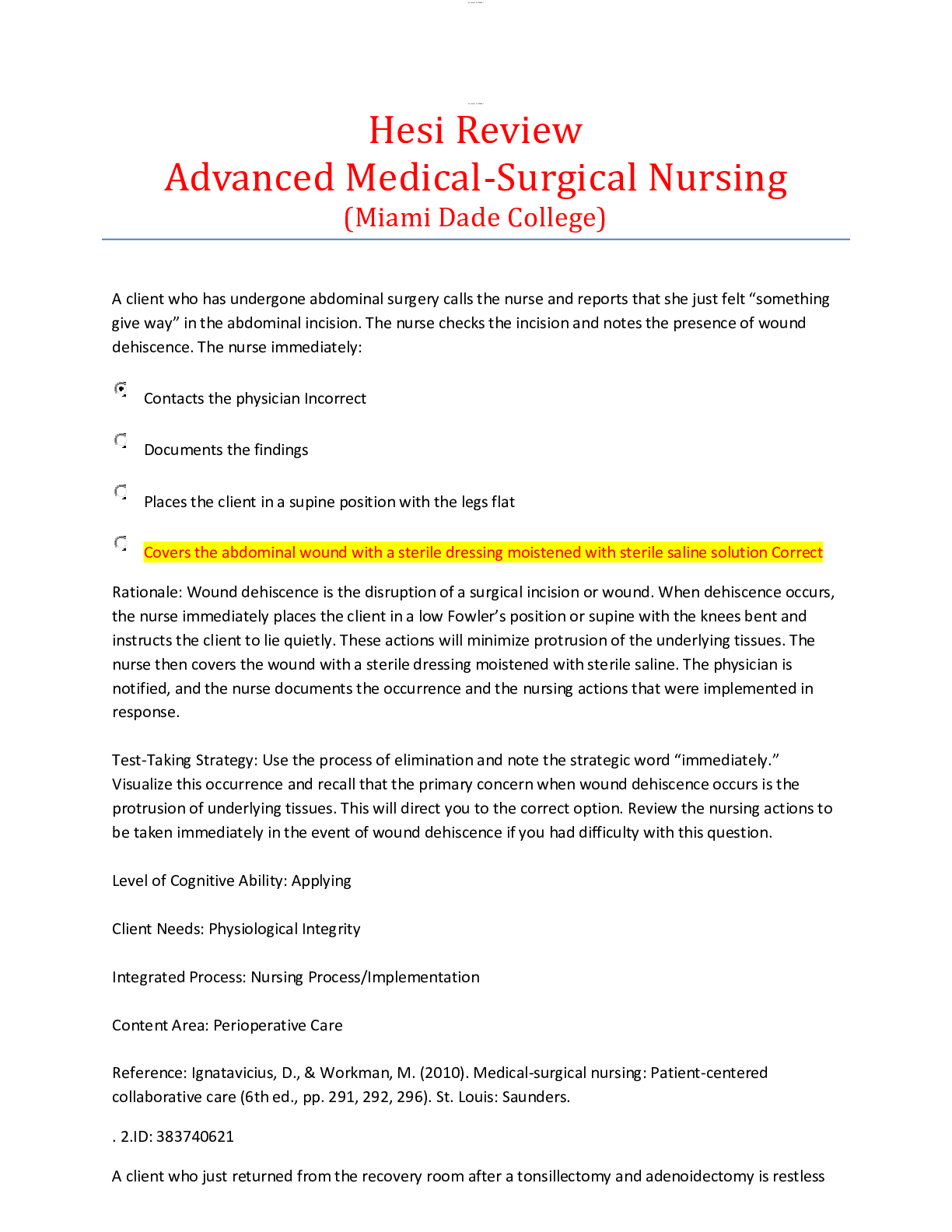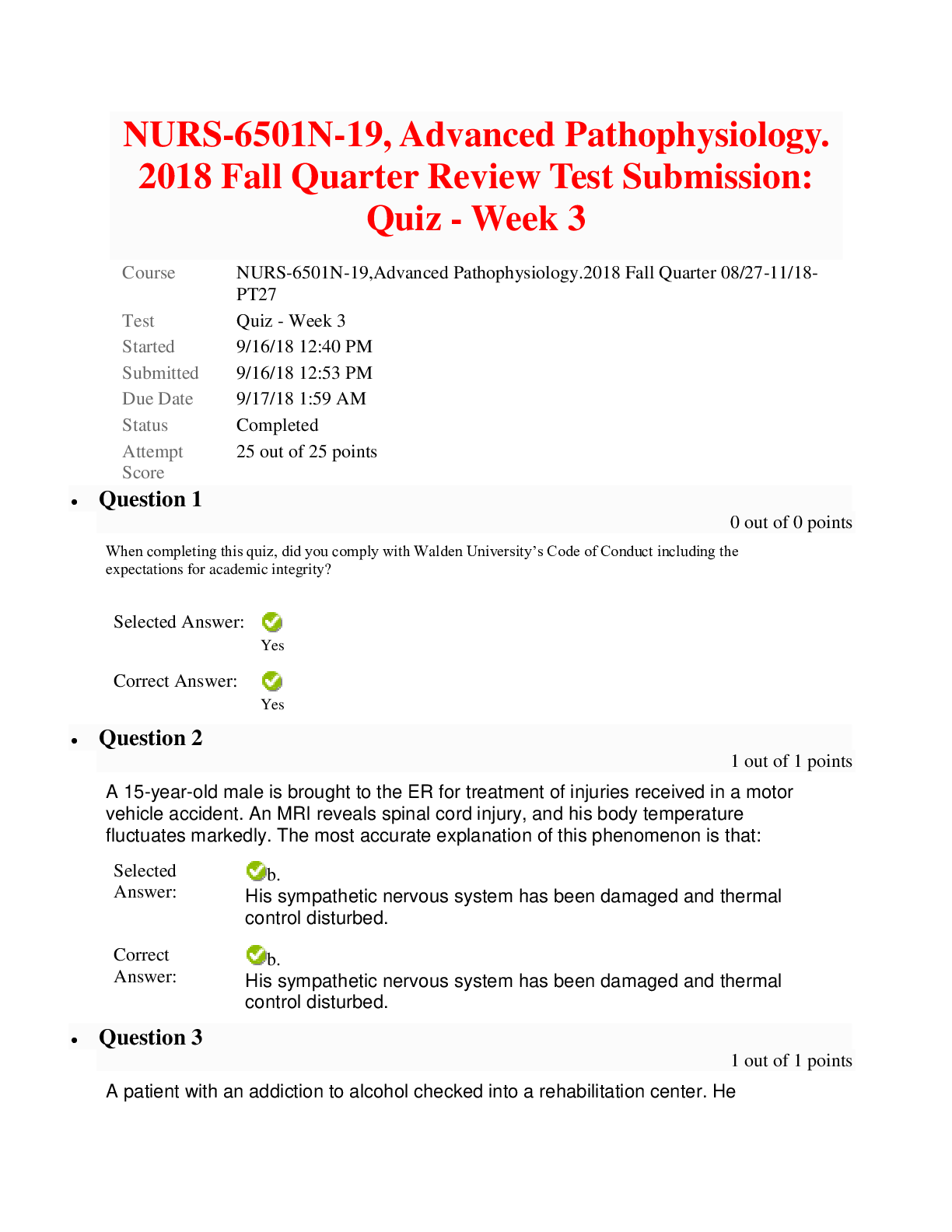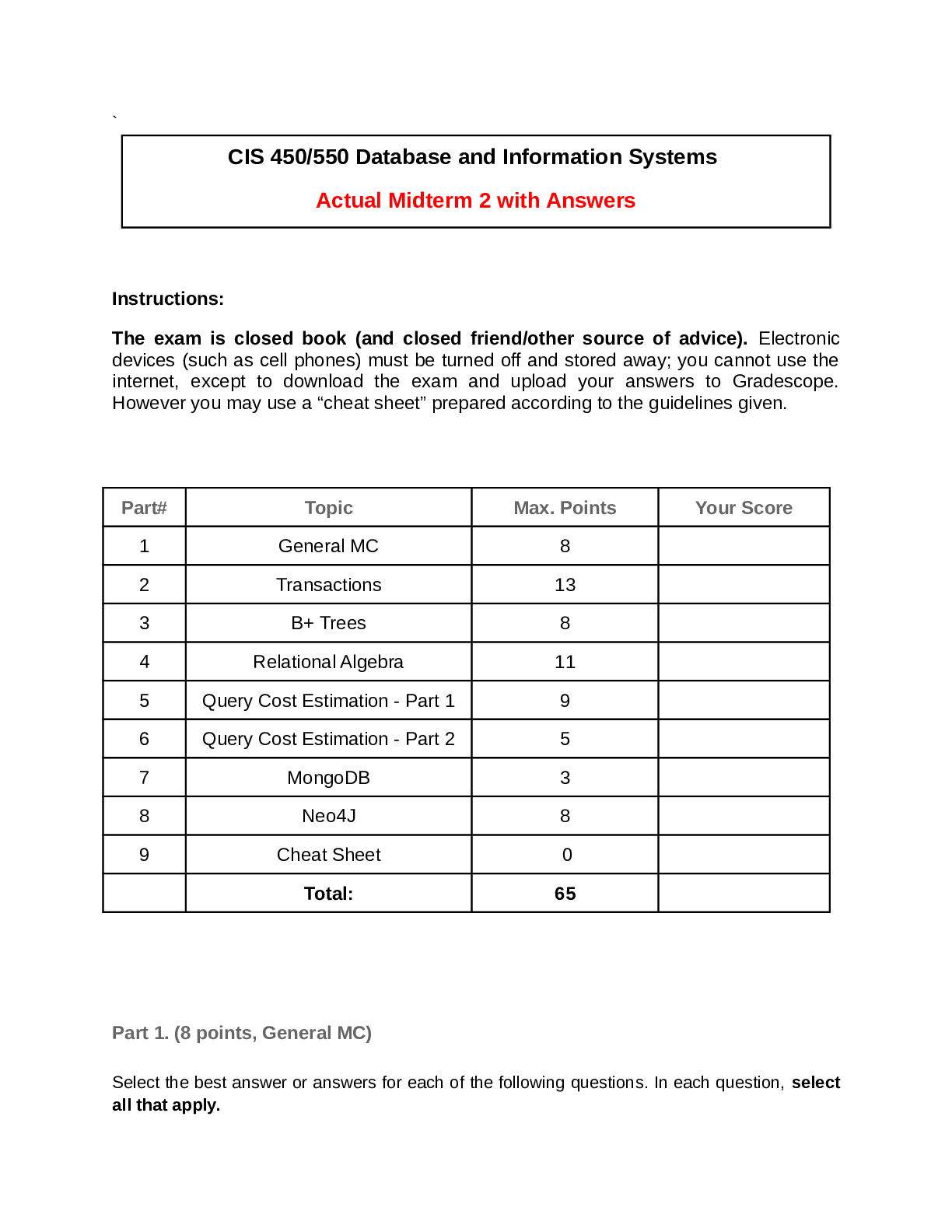Financial Accounting > QUESTIONS & ANSWERS > OPERATIONS MANAGEMENT AND INFORMATION SYSTEMS (OMIS): OMIS 320 Exam 2. (All)
OPERATIONS MANAGEMENT AND INFORMATION SYSTEMS (OMIS): OMIS 320 Exam 2.
Document Content and Description Below
OPERATIONS MANAGEMENT AND INFORMATION SYSTEMS (OMIS): OMIS 320 Exam 2 MULTIPLE CHOICE 1. All of the following are reasons for the increasing use of ethical and sustainable sourcing practices EX... CEPT: c. 2. Managing a firm's external resources in ways that support the long-term goals of the firm can be referred to as: 3. The management of the firm's external resources through identification and selection of suppliers, management of supplier relationships, and monitoring and rewarding supplier performance in an effort to support the long-term goals of the organization is called: d. 4. Which of the following is NOT a step suggested in the Supply Chain Sourcing Strategy Framework? c. 5. Which of the following are considered outcomes of implementing a supplier evaluation and selection criteria? d. 6. The application of ethical principles to business situations can be referred to as: 7. The following term refers to an act that creates the greatest good for the greatest number of people: 8. The purchasing managers at Sunnydale Corporation decide to intentionally increase purchases from small, women-owned suppliers. This decision can be considered: 9. The Ethical Trading Initiative (ETI) does NOT include which of the following: 10. Wal-mart is the driving force behind a system of measurement intended to influence how products are made and purchased in the future. This system of measurement is the: 11. According to the EcoMarkets survey, which surveys over 6000 private and public buyers, the most popular aspect of green sourcing is: a. Recycling b. Material reuse c. Energy conservation d. Packaging reuse C PTS: 1 REF: p. 108 12. Which of the following would most likely be considered a functional product? a. PDA − Personal Digital Assistant b. HDTV − High Definition Televisions c. DVD recorders d. Disposable Camera D PTS: 1 REF: p. 109 13. The textbook outlined a Supply Chain Ethical and Sustainability Sourcing Strategy Framework. How many steps are in this framework? C PTS: 1 REF: p. 109-111 14. Harold's Fish Shop decides to reduce its purchases from poorly performing fish suppliers and focus future orders with suppliers that have been top-performing in the past. This is an example of: a. Supply base rationalization b. Supplier development c. Top-tier supplier selection d. Selective sourcing B PTS: 1 REF: p. 112 15. Hard-bargaining sourcing departments focused on decreasing purchasing spend may experience which of the following from their suppliers? a. Lower levels of quality from their suppliers b. Lower levels of service from their suppliers c. Deteriorating buyer-supplier relationships d. All of these D PTS: 1 REF: p. 112-113 16. An outsourcing program can result in all of the following positive outcomes, except: a. Reducing staffing levels b. Decreased need for supplier management c. Cost reduction d. Gains in manufacturing flexibility B PTS: 1 REF: p. 113-114 17. Variations of outsourcing include all of the following EXCEPT: (C; 114) a. Co-sourcing b. Selective sourcing c. Front sourcing d. Insourcing C PTS: 1 REF: p. 114 18. One of the most value enhancing activities performed by a supplier, for a key customer, which minimizes carrying costs and can avoid stockouts: a. Early supplier involvement scheduling b. Vendor managed inventory c. Strategic inventory planning d. Purchase spend reduction forecasting B PTS: 1 REF: p. 116 19. Which of the following is FALSE? a. The use of 3PL's has been increasing as companies seek more effective supply chain strategies. b. VMI provides retail facilities the opportunity to communicate to manufacturers that the customers are requesting customized items c. The use of 3PL providers allows companies to gain competitive advantages without having to gain the required knowledge through firsthand experience. d. VMI allows suppliers to manage their customers' inventory provided they have the capability to see inventory levels in real time B PTS: 1 REF: p. 116 20. Which of the following is TRUE? a. VMI stands for Vertically Managed Inventory b. 3PL stands for Third Party Leverage c. VMI stands for Vendor-Managed Inventory d. 3PL stands for Three Point Logistics C PTS: 1 REF: p. 116 21. The inventory level where suppliers replenish their customer's inventory with a predetermined order quantity is called the: a. Channel Equity Level b. Reorder point c. Bill Back d. MRO point B PTS: 1 REF: p. 116-117 22. According to the textbook, collaborative relationships place a relatively lower importance rating on which of the following competitive priorities: a. Speed of Delivery b. Cost c. Product Quality d. Frequency of deliveries B PTS: 1 REF: p. 120-121 23. The primary benefits of ____ include costs savings and freeing up time for purchasing staff to concentrate on the firm's core activities. a. eProcurement b. Insourcing c. The Ethical Trade initiative d. Six Sigma B PTS: 1 REF: p. 121 24. Which of the following can be used as a punishment for suppliers that perform poorly? a. Elimination of future business with the focal firm b. Downgrade the supplier's status c. Billback penalty d. All of these D PTS: 1 REF: p. 123 25. Benchmarking is: a. A system of performance metrics that seeks to motivate suppliers to perform better. b. A practice where companies attempt to learn and apply the best practices of other companies. c. A system of marking defective inbound inventory so it can quickly be identified for return to the supplier. d. A program where suppliers compete for contracts, but those companies who are outbid are provided advice for winning future contracts B PTS: 1 REF: p. 124 MULTIPLE CHOICE 1. Which of the following indices provided by the Institute for Supply Management (ISM) is considered the most important by economists because it is a composite of five weighted, seasonally adjusted indices? a. Purchasing Managers Index b. Export Orders Index c. Production and Inventory Index d. New Orders Index A PTS: 1 REF: p. 134 2. According to the textbook, which of the following is NOT a way to closely match supply and demand? a. Holding high amounts of inventory b. Maintaining a rigid pricing system c. Utilizing overtime d. Hiring temporary workers B PTS: 1 REF: p. 135 3. The impact of poor communication and inaccurate forecasts resonates along the supply chain and results in the: a. Bullwhip effect b. Delphi method c. CPFR effect d. Mean deviation A PTS: 1 REF: p. 136 4. Inaccurate forecasts can result in negative outcomes like: a. Stockouts and poor responsiveness to market dynamics b. High inventory costs of inventory and increased profits c. Material shortages and decreased costs of obsolescence d. Low inventory costs of inventory and stockouts A PTS: 1 REF: p. 136 5. Which one of the following is not a type of qualitative forecasting? a. Sales force composite b. Consumer survey c. Jury of executive opinion d. Naïve method D PTS: 1 REF: p. 138 6. The following are all common qualitative forecasting models EXCEPT: a. Jury of Executive Opinion b. Trend Variation c. Delphi Method d. Sales Force Composite B PTS: 1 REF: p. 138 7. Which of the following statements is FALSE: a. Time Series forecasting is based on the assumption that the future is an extension of the past b. Cause-and-Effect forecasting assumes that one or more factors are related to demand and, therefore, can be used to predict future demand c. All quantitative methods become less accurate as the forecast's time horizon increases d. It is generally not recommended to use a combination of both quantitative and qualitative methods D PTS: 1 REF: p. 139 8. Your company is conducting forecasting that revolves around the current recession and expansion of the U.S. economy. This type of forecasting can be referred to as what component of a time series? a. Trend Variations b. Cyclical Variations c. Seasonal Variations d. Random Variations B PTS: 1 REF: p. 139 9. The following time-series approach to forecasting uses historical data to generate a forecast and works well when demand is fairly stable over time: a. Naïve Forecast b. Weighted Moving Average c. Simple Moving Average d. Exponential Smoothing C PTS: 1 REF: p. 140 Data Set E1 10. Using Data Set E1, what would be the forecast for period 7 using a four period moving average: (Choose the closest answer.) D PTS: 1 REF: p. 140 11. Using Data Set E1, what would be the forecast for period 6 using a five period weighted moving average? The weights for each period are 0.05, 0.10, 0.20, 0.30, and 0.35 from the oldest period to the most recent period, respectively. (Choose the closest answer.) A PTS: 1 REF: p. 140 12. Using Data Set E1, what would be the forecast for period 6 using the exponential smoothing method? Assume the forecast for period 5 is 14000. Use a smoothing constant of = 0.4 (Choose the closest answer.) C PTS: 1 REF: p. 143 13. Using the actual demand shown in the table below, what is the forecast for May (accurate to 1 decimal) using a 4-month weighted moving average and the weights 0.1, 0.2, 0.3, 0.4 (with the heaviest weight applied to the most recent period)? A PTS: 1 REF: p. 140 14. Given the following information, calculate the forecast (accurate to 2 decimals) for period three using exponential smoothing and = 0.3. D PTS: 1 REF: p. 143 15. The exponential smoothing forecast has the same value as the naïve forecast when in the exponential smoothing model is equal to: C PTS: 1 REF: p. 143 16. The equation for a simple linear regression that saw sales averaging $225,000 over the last ten periods, and advertising budgets averaging $3,000 over the last 10 periods is: Y = 3250 + 120x This indicates that a $1 increase in advertising will increase sales by: C PTS: 1 REF: p. 144 17. One common Cause-and-Effect Model used is: a. Regression analysis b. Linear Trend Forecast c. Moving Average Forecast d. Mean Absolute Deviation A PTS: 1 REF: p. 145 18. Some measures of forecasting accuracy include mean absolute deviation, mean absolute percentage error, and mean squared error. The formula for each is dependent on the forecast error, which is calculated by using the equation: a. Actual demand for period t divided by the forecasted demand for period t b. Actual demand for period t plus the forecasted demand for period t c. Actual demand for period t minus the forecasted demand for period t d. The average of Actual demand for period t and forecasted demand for period t C PTS: 1 REF: p. 148 19. If a tracking signal is positive, which one of the following is true? a. Actual value is higher than forecast b. Actual value is less than forecast c. Actual value is equal to forecast d. Unable to draw any conclusion A PTS: 1 REF: p. 148 Data Set E2 20. A forecasting method has produced the following data over the past 5 months shown in Data Set E2. What is the mean absolute deviation (accurate to 2 decimals)? 21. Based on the information in Data Set E2, what is the mean squared error (accurate to 2 decimals)? 22. What does the acronym CPFR represent? 23. According to textbook, the top three challenges for CPFR implementation include all of the following except: 24. According to textbook, which of the following companies is a leading forecasting software provider? 25. According to textbook, which of the following companies is recognized as a leader in CPFR software solutions? 1. Which of the following is an engineering document that shows an inclusive listing of all the component parts and assemblies making up the final product? 2. The goal of resource planning is to minimize the discrepancy between capacity and: 3. Which of the following consists of different products that share similar characteristics, components or manufacturing processes? 4. Which of the following seeks to develop short range plans seeking to effectively and efficiently manage components and/or subassemblies over time period of few days to a few weeks? 5. To check the feasibility of the Master Production Schedule, one would look to: 6. Which of the following is a Long Range Materials Plan: 7. In a bill of materials, items at which level are independent demand items? 8. Which of the following basic production strategies used for addressing the aggregate planning problem would work best with make-to-order manufacturing firms? 9. Which of the following could be considered a master production schedule for a service firm? 10. Which of the following is NOT one of the three basic methods used to calculate the available-to-promise quantities? c. Indiscrete available-to-promise 11. Which of the following MRP terms represents a committed order awaiting delivery for a specific period? d. Scheduled receipt 12. Which of the following MRP terms represents the parts demanded by a parent? b. Component 13. Which number should be placed in the spot presently filled with the X? b. 75 14. Which number should be placed in the spot presently filled with the X? c. 30 15. Which number should be placed in the spot presently filled with the X? b. 5 16. Which number should be placed in the spot presently filled with the X? c. 45 17. The acronym ERP is short for: a. Enterprise Resource Planning 18. Which of the following is considered an advantage/benefit of utilizing in ERP system? c. Allows organizations to more easily communicate information about operational changes to supply chain members 19. Which of the following is considered an advantage/benefit of utilizing an ERP system? b. Enables the company to utilize a single centralized database system, thus eliminating duplicate data entry. 20. While ERP is a relatively new technology, it has grown rapidly since the early 1990s. Which of the following is the reason that has contributed to its rapid growth? a. 21. Organizations that choose to implement one single system with all of the desired applications from a single vendor versus choosing to implement the best applications or modules for each of the different functional departments associated with the supply chain is said to have chosen a(n): c. 22. Organizations that choose to implement the best applications or modules for each of the different functional departments associated with the supply chain versus choosing to implement one single system with all of the desired applications from a single vendor is said to have chosen a(n): a. 23. According to the textbook, which of the following is considered a reason that ERP implementations fail? a. 24. Not all ERP software is designed to provide the exact same tools, nonetheless, some of the common modules usually included in ERP software packages include: d. 25. Which of the following is NOT a common module of ERP systems? c. [Show More]
Last updated: 2 years ago
Preview 1 out of 15 pages

Buy this document to get the full access instantly
Instant Download Access after purchase
Buy NowInstant download
We Accept:

Reviews( 0 )
$9.00
Can't find what you want? Try our AI powered Search
Document information
Connected school, study & course
About the document
Uploaded On
Sep 20, 2020
Number of pages
15
Written in
Additional information
This document has been written for:
Uploaded
Sep 20, 2020
Downloads
0
Views
171



